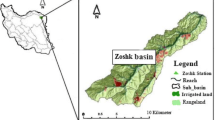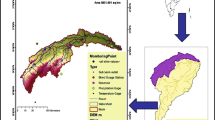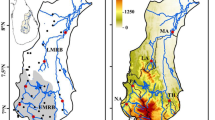Abastract
The ideal allotment of controlled water assets for diversified schemes is needed for continuous and controlled advancement. In present study SWAT (Soil and Water Assessment Tool), a physically based semi-distributed hydrological model was applied in the Satluj Basin (Suni to Kasol) for hydrologic modeling. 23 sub-basins were demarcated from the study area, which consists of 325 Hydrological Response Units (HRUs) with regard to specific slope, soil and land use combination. SWAT-CUP (SWAT-Calibration and Uncertainty Programs) is one of the new developments for calibration/sensitivity analysis of watershed models that incorporate a semi-automated approach SUFI-2 (Sequential Uncertainty Fitting) which includes both manual and automatic calibration and incorporating global sensitivity analysis. Parameters for Sensitivity Analysis used to measure statistics for goodness-of-fit. For the study area, CN2, SOIL_K, RCHRG_DP, CH_K2 were considered as the most sensitive parameters. The model Calibration (1986–1998) and Validation (1999–2011) were executed with initial 3 years considered as a warm-up period (1983–1985) at Kasol site which is considered as anoutlet of the study area. The statistical performance of the model was assessed using the coefficient of variation (R2), and Nash–Sutcliffe efficiency (NSE), during model Calibration, R² for the daily runoff was obtained as 0.98 with Nash-Sutcliff of 0.96 respectively. The validation also signified satisfactory results with R2 of 0.96 and NSE of 0.94 respectively. The results have shown excellent correlation between observed and simulated discharge on daily time steps. The results and ensuing inferences would be of immense help to the hydrological fraternity and the water resource managers.










Similar content being viewed by others
References
Abbaspour KC, Sonnleitner MA, Schulin R (1999) Uncertainty in estimation of soil hydraulic parameters by inverse modeling: example lysimeter experiments. Soil Sci Soc Am J 63(3):501–509
Abbaspour KC, Vejdani M, Haghighat S, Yang J (2007) SWAT-CUP calibration and uncertainty programs for SWAT. In: MODSIM 2007 International Congress on Modelling and Simulation, Modelling and Simulation Society of Australia and New Zealand, pp. 1596–1602
Arnold JG, Srinivasan R, Muttiah RS, Williams JR (1998) Large area hydrologic modelling assessment—part I: model development. J Am Water Resour Assoc 34:73–89
Bloschl G, Sivapalan M (1995) Scale issues in hydrological modelling, a review. Hydrol Process 353:18–32
CWC (Central Water Commission) (2005) Water Data Book. CWC, New Delhi. Available: http://cwc.gov.in/main/downloads/Water_Data_Complete_Book_2005.pdf
Dhali K, Sahana M (2017) Spatial variation in fluvial hydraulics with major bed erosion zone: a study of Kharsoti river of India in the post monsoon period Arabian J Geosci. https://doi.org/10.1007/s12517-017-3205-8 (Springer)
Ganaie TA, Sahana M. Hashia H (2017) Assessing and monitoring the human influence on water quality in response to land transformation within Wular environs of Kashmir Valley. Geojournal. https://doi.org/10.1007/s10708-017-9822-7 (Springer)
Gyamfi C, Ndambuki JM, Salim RW (2016) Application of SWAT model to the Olifants Basin: calibration, validation and uncertainty analysis. J Water Resour Prot 8:397–410
Jain SK, Tyagi, J, Singh, V (2010) Simulation of runoff and sediment yield for a Himalayan watershed using SWAT model. J Water Resour Prot 2(03): 267–281
Khalid K et al (2014) Application on one-at-a-time sensitivity analysis of semidistributed hydrological model in tropical watershed. IACSIT Int J Eng Technol 8(2):132
Mishra SK, Singh V (2003) Soil conservation service curve number (SCS-CN) methodology. vol 42. Springer, New York, 516
Murty PS, Pandey A, Suryavanshi S (2013) Application of semi-distributed hydrological model for basin level water balance of the Ken basin of Central India. Hydrol Process. https://doi.org/10.1002/hyp.9950
Narsimlu B, Gosain AK, Chahar BR, Singh SK, Srivastava PK (2015) SWAT model calibration and uncertainty analysis for streamflow prediction in the Kunwari River Basin, India, using sequential uncertainty fitting. Environ Process 2:79–95. https://doi.org/10.1007/s40710-015-0064-8
Neitsch SL, Arnold JG, Kiniry JR, Williams JR (2005) Soil and water assessment tool, theoretical documentation: Version 2005. Temple, TX. USDA Agriculture Research Service and Texas A&M Black Land Research Center
Patel D, Srivastava P (2013) Flood hazards mitigation analysis using remote sensing and GIS: correspondence with town planning scheme. Water Resour Manag 27:2353–2368. https://doi.org/10.1007/s11269-031-0291-6
Patel DP, Srivastava PK (2014) Application of geo-spatial technique for flood inundation mapping of low lying areas. In: Remote sensing applications in environmental research. Springer, New York, pp 113–130
Patel DP, Gajjar CA, Srivastava PK (2013) Prioritization of Malesari mini-watersheds through morphometric analysis: a remote sensing and GIS perspective. Environ Earth Sci 69:2643–2656
Rosenthal W, Hoffman D (1999) Hydrologic modellings/SIS as an aid in locating monitoring sites. Trans ASAE 42:1591–1598
Sahana M. Sajjad H (2017) Evaluating effectiveness of frequency ratio, fuzzy logic and logistic regression models in assessing landslide susceptibility: a case from Rudraprayag district, India. J Mt Sci. https://doi.org/10.1007/s11629-017-4404-1 (Springer)
Sahana M, Sajjad H, Ahmed R (2015) Assessing spatio-temporal health of forest cover using forest canopy density model and forest fragmentation approach in Sundarban reserve forest, India. Model Earth Syst Environ 1(4):49
Sahana M, Ahmed R, Sajjad H (2016) Analyzing land surface temperature distribution in response to land use/land cover change using split window algorithm and spectral radiance model in Sundarban Biosphere Reserve, India. Model Earth Syst Environ 2(2):81
Sahana M, Hong H, Sajjad H, Liu J, Zhu AX (2018a) Assessing deforestation susceptibility to forest ecosystem in Rudraprayag district, India using fragmentation approach and frequency ratio model. Sci Total Environ 627:1264–1275. https://doi.org/10.1016/j.scitotenv.2018.01.290 (Elsevier)
Sahana M, Hong H, Sajjad H (2018b). Analyzing urban spatial patterns and trend of urban growth using urban sprawl matrix: a study on Kolkata urban agglomeration, India. Sci Total Environ 628–629:1557–1566. https://doi.org/10.1016/j.scitotenv.2018.02.170 (Elsevier)
Shi P, Chen C, Srinivasan R, Zhang X, Cai T, Fang X, Li Q (2011) Evaluating the SWAT model for hydrological modelling in the Xixian watershed and a comparison with the XAJ model. Water Resour Manag 25:2595–2612. https://doi.org/10.1007/s11269-011-9828-8
Shivhare V, Goel MK, Singh CK (2014). Simulation of Surface Runoff for Upper Tapi Subcatchment Area (Burhanpur Watershed) Using Swat. The International Archives of Photogrammetry, Remote Sensing and Spatial Information Sciences 40(8):391
Singh V, Bankar N, Salunkhe SS, Bera AK, Sharma JR (2013) Hydrological stream flow modelling on Tungabhadra catchment: parameterization and uncertainty analysis using SWAT CUP. Curr Sci 104(9):1187–1199
Singh S, Srivastava P, Gupta M, Thakur J, Mukherjee S (2014) Appraisal of land use/ land cover of mangrove forest ecosystem using support vector machine. Environ Earth Sci 71:2245–2255. https://doi.org/10.1007/s12665-013-2628-0
Sophocleous M (2002) Interactions between groundwater and surface water. The state of the science. Hydrogeol J 10:52–67
Spruill C, Workman S, Taraba J (2000) Simulation od daily and monthly stream discharge from small watersheds using the SWAT model. Trans ASAE 43:1431–1439
Srinivas JS, Kumar TKS, Reshma T (2016) Simulation of runoff for an experimental watershed using SWAT. Int J Tech Res Appl 4:364–369
Srivastava PK, Han D, Ramirez MR, Bray M, Islam T (2012) Selection of classification techniques for land use/land cover changes investigation. Adv Space Res 50:1250–1265
Srivastava PK, Han D, Ramirez MR, Islam T (2013) Machine learing techniques for downscaling SMOS satellite soil moisture using MODIS land surface temperature for hydrological application. Water Resour Manag 27:3127–3144
Stehr A, Debels P, Arumi JL, Romero F, Alcayaga H (2009) Combining the soil and water assessment tool and MODIS imagery to estimate monthly flows in a data-scarce Chilean Andean basin. Hydrol Sci 54(6):1053–1067
Strayer DL, Ewing HA, Bigelow S (2003) What kind od spatial and temporal details are required in models of heterogeneous systems? Oikos 102:654–662
Wagener T, Wheater HS (2006) Parameter estimation and regionalization of continuous rainfall-runoff models including uncertainty. J Hydrol 320:132–154
Yadav SK, Singh SK, Gupta M, Srivastava PK (2013) Morphometric analysis of Upper Tons basin from Northern Foreland of Peninsular India using CARTOSAT satellite and GIS. Geocarto International 29(8):895–914
Zhang X, Srinivasan R, Liew MV (2010) On the use of multi-algorithm, genetically adaptive multi-objective method for multi-site calibration of the SWAT model. Hydrol Process 24:955–969s
Acknowledgements
The authors are incredibility grateful to the anonymous reviewers and the executive chief editor Prof. Md. Nazrul Islam for their constrictive comments and suggestions, which helped to improve the overall quality of the present work.
Funding
No funding was received from any agency for conducting this study.
Author information
Authors and Affiliations
Corresponding author
Ethics declarations
Conflict of interest
All the authors declare that they have no conflict of interest.
Rights and permissions
About this article
Cite this article
Khatun, S., Sahana, M., Jain, S.K. et al. Simulation of surface runoff using semi distributed hydrological model for a part of Satluj Basin: parameterization and global sensitivity analysis using SWAT CUP. Model. Earth Syst. Environ. 4, 1111–1124 (2018). https://doi.org/10.1007/s40808-018-0474-5
Received:
Accepted:
Published:
Issue Date:
DOI: https://doi.org/10.1007/s40808-018-0474-5




